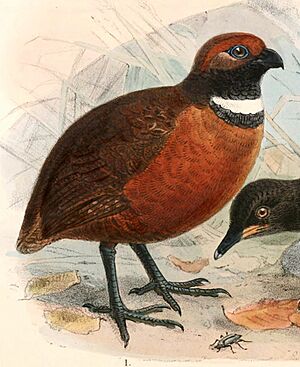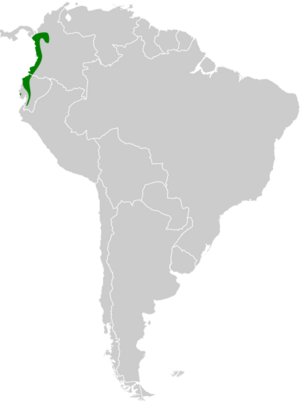Rufous-fronted wood quail facts for kids
Quick facts for kids Rufous-fronted wood quail |
|
|---|---|
 |
|
| Conservation status | |
| Scientific classification | |
| Genus: |
Odontophorus (bird)
|
| Species: |
erythrops
|
 |
|
The rufous-fronted wood quail (Odontophorus erythrops) is a type of bird that belongs to the New World quail family, called Odontophoridae. You can find this bird in the countries of Colombia and Ecuador.
Contents
Meet the Rufous-Fronted Wood Quail
What Does This Quail Look Like?
The rufous-fronted wood quail is about 23 to 28 centimeters (9 to 11 inches) long. That's about the length of a ruler! Male quails weigh around 340 grams (12 ounces), and females are a little lighter at about 329 grams (11.6 ounces).
The male bird has a reddish-brown (rufous) head, a crest on top, and a reddish face. Around its eye, there's a ring of bare purple skin. Its back and rump can be black or olive green, often with black spots. The chest and belly are also a dark reddish-brown.
The female's face is a darker and less bright reddish-brown, and the skin around her eye is blue-black. Young quails look similar to the females but have black spots and bars on their belly.
There are two main types, or subspecies, of this quail. One type has darker upper parts and a white throat.
Where Do These Quails Live?
You can find the rufous-fronted wood quail in different parts of Ecuador and Colombia. One type lives in southwestern Ecuador. The other type is found more widely, living on the Pacific side of western Ecuador and western Colombia. It also lives in Colombia's Magdalena Valley.
These birds like to live in humid tropical forests, both old, untouched forests and newer ones that have grown back. In Ecuador, they can live up to 1,600 meters (5,200 feet) high in the mountains, but in Colombia, they usually stay below 1,100 meters (3,600 feet).
Life and Habits of the Rufous-Fronted Wood Quail
What Do Rufous-Fronted Wood Quails Eat?
Scientists haven't studied the diet of the rufous-fronted wood quail much. However, people have seen them eating grain at special feeding stations near lodges. This suggests they might eat seeds and grains.
Reproduction and Life Cycle
The breeding season for the rufous-fronted wood quail is thought to be from January to May. We don't have much more information about how they raise their young, but it's an interesting area for future study!
How Do These Quails Communicate?
The rufous-fronted wood quail has at least two main calls. One is a fast, ringing sound that they often make together, like a duet. It sounds like "chowita, chowita, chowita." They also have a deep, echoing call that sounds like "koo-klaw, koo-klaw, koo-klaw."
Status and Protection
The IUCN (International Union for Conservation of Nature) has looked at the rufous-fronted wood quail and decided it is a species of "Least Concern." This means they are not currently in danger of disappearing.
These quails live in several protected areas, which helps keep them safe. However, outside these protected places, big problems like deforestation (when forests are cut down) and possibly hunting could threaten them. Protecting their forest homes is very important for their future.


